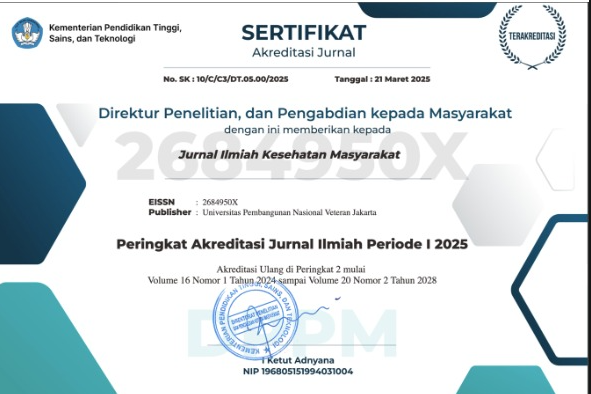Faktor–Faktor yang Mempengaruhi Kunjungan Nifas Lengkap di Indonesia: Analisis Lanjut Data Riskesdas 2018
Abstract
Abstrak
Latar Belakang: Perawatan nifas dibutuhkan pada periode setelah persalinan untuk mendeteksi dini masalah atau mengobati penyakit pascapersalinan. Lebih dari 65% kematian ibu terjadi selama 42 hari pertama pascapersalinan. Penelitian ini bertujuan untuk menganalisis faktor-faktor yang mempengaruhi kunjungan nifas lengkap di Indonesia.
Metode: Penelitian menggunakan data Riset Kesehatan Dasar (Riskesdas) 2018. Unit analisis penelitian ini adalah ibu yang melahirkan anak terakhir dalam kurun 2013 sampai wawancara Riskesdas 2018.
Hasil: Berdasarkan hasil regresi logistik, faktor predisposisi yang memiliki peluang untuk mempengaruhi kunjungan nifas lengkap adalah umur ibu 20-35 tahun (OR 0,885), pendidikan tinggi (OR 1,167), paritas ≤ 2(OR 1,090), persalinan secara sesar/vacuum/forceps, dll (OR 1,491), persalinan di fasilitas kesehatan (OR 1,489), pemeriksaan kehamilan lengkap (OR 1,613), dan regional Sumatera (OR 0,510). Faktor pemungkin yang memiliki peluang untuk mempengaruhi kunjungan nifas lengkap adalah status tidak bekerja (OR 0,954) dan memiliki jaminan kesehatan (OR 1,141). Faktor kebutuhan yang memiliki peluang untuk mempengaruhi kunjungan nifas lengkap adalah memiliki riwayat komplikasi kehamilan (OR 0,948).
Kesimpulan: Faktor-faktor yang mempengaruhi kunjungan nifas lengkap adalah umur ibu, pendidikan, paritas, metode persalinan, tempat persalinan, pemeriksaan kehamilan, regional tempat tinggal, status pekerjaan, kepemilikan jaminan kesehatan, dan riwayat komplikasi kehamilan.
The Determinants of Fully Postpartum Visit in Indonesia: Further Analysis of Riskesdas 2018
Abstract
Background: Post-natal care is needed during postpartum for early detection or to cure disease or any problem of postpartum. More than 60% of maternal mortality happens during 42 days of postpartum. This research is intended to analyse the determinant factors of fully postpartum visit in Indonesia.
Method: This research uses the data from Riskesdas 2018. The unit of analytic research is mothers having last birth happened from 2013 until Riskesdas interview on 2018.
Result: Based on the result of logistic regression, predisposition factors that have chance to affect the fully postpartum visit are mothers on age 20-35 years old (OR 0,885), advance education (OR 1,167), parity ≤2 (OR 1,090), laboring through caesar, vacuum, forceps et all (OR 1,491), labor using medical facility (OR 1,489), fully pregnancy checkup (OR 1,613) and region Sumatera (OR 0,510). Enabling factors that have chance to affect the fully postpartum visit are unemployment (OR 0,954) and owning health insurance (OR 1,141). Need factor that has chance to affect fully postpartum visit is having history of pregnancy complications (OR 0,948).
Conclusion: The factors affecting fully postpartum visit are age, education, parity, labor method, place of labor, pregnancy checkup and region of province, job status, health insurance ownership and history of pregnancy complication.
References
ASEAN. Asean Sustainable Development Goals Indicators Baseline Report 2020
Databooks. Angka Kematian Ibu Indonesia Cenderung Turun. (dikutip 9 februari 2021) Tersedia pada https://databoks.katadata.co.id/datapublish/2019/10/08/tren-angka-kematian-ibu-di-indonesia
UN. The Sustainable Development Agenda. 2015.
https://www.un.org/ga/search/view_doc.asp?symbol=A/RES/70/1&Lang=E
Profil Kesehatan Indonesia Tahun 2019
Tessema, ZE, Yazachew L, Tesema GA, Thesale AB. 2020. Determinants of Postnatal Care Utilization in Sub-Saharan Africa: A Meta and Multilevel Analysis of Data From 36 Sub-Saharan Countries. Italian Journal of Pediatrics 46, Article number: 175 (2020)
WHO. Maternal Mortality. 2018. (Dikutip 26 Januari 2021) Tersedia pada https://www.who.int/news-room/fact-sheets/detail/maternal-mortality
Weisssmann-Brenner A, Heusler I, Manteka R, Dulitzky M, Baum M. Postpartum Visits in The Gynecological Emergency Room: How Can We Improve?. BMC Pregnancy and Childbirth, 2020, vol (20), Article number: 278.
Achady E.L, 2017. Kematian Maternal dan Neonatal di Indonesia. Banten. Bahan Presentasi Rakernas 2019, Kemenkes RI.
Nurrizka AR, Wahyono TYM. Disparity of Maternal Mortality in Indonesia: Ecological Study with Spatial Analysis. Jurnal MKMI, 2018 Juni Vol (14) No 2.
Kemenkes RI. Panduan Pelayanan Pascapersalinan bagi Ibu dan Bayi Baru Lahir. 2019.
Kementerian Kesehatan RI. Riskesdas 2018 [Internet]. Riset Kesehatan Dasar 2018. 2018 (dikutip 26 Januari 2021) Tersedia pada https://www.litbang.kemkes.go.id/laporan-riset-kesehatan-dasar-riskesdas/.
Bwalya BB, Mulenga MC, Mulenga JN. Factors Associated with Postnatal Care for New Born in Zambia: Analysis of The 2013-14 Zambia Demographic and Health Survey. BMC Pregnancy and Childbirth, 2017 17(1), 1–13. https://doi.org/10.1186/s12884-017-1612-1
Rosita M. Hubungan Antara Pendidikan, Usia dan Paritas Ibu Nifas dengan Kunjungan Masa Nifas Di Bidan Praktik Mandiri Suryati Palembang Tahun 2017. Jurnal Aisyiyah Medika ,2017 Februari, Vol (1).
Akibu M, Tsegaye W, Megersa T, Nurgi S. Prevalence and Determinants of Complete Postnatal Care Service Utilization in Northern Shoa, Ethiopia. Journal of Pregnancy, 2018, Article ID 8625437. | https://doi.org/10.1155/2018/8625437
Chola M, Chungu C, Makasa M, Jacobs C. Place of Delivery Associated with Postnatal Care Utilization among Childbearing Women in Zambi. Front Public Health, 2018 April 6:94.
Ndugga P, Namiyonga NK, Sebuwufu D. Determinants of Early Postnatal Care Attendance: Analysis of The 2016 Uganda Demographic and Health Survey. BMC Pregnancy and Childbirth, 2020, Vol 20, Article number: 163.
Mohammed Akibu, Wintana Tsegaye, Tewodros Megersa, & Sodere Nurgi. Prevalence and Determinants of Complete Postnatal Care Service Utilization in Northern Shoa, Ethiopia. Journal of Pregnancy, 2018, Article ID 8625437. | https://doi.org/10.1155/2018/8625437
Permenkes RI Nomor 97 Tahun 2014 tentang Pelayanan Kesehatan Masa Sebelum Hamil, Masa Hamil,Persalinan, dan Masa, Sesudah Melahirkan, Penyelenggaraan Pelayanan Kontrasepsi, Serta Pelayanan Kesehatan Seksual. Kemenkes RI. 2014.
Nugraha, SM. Determinan Akses Pelayanan Nifas di Indonesia (Analisis Riskesdas 2010). [tesis]. Depok Jawa Barat: Fakultas Kesehatan Masyarakat UI.; 2013.
UU Nomor 40 Tahun 2004 Tentang Sistem Jaminan Sosial Nasional. Pemerintah Republik Indonesia. 2004.
Widyawati E. Hubungan Status Jaminan Kesehatan Nasional dengan Kepatuhan Kunjungan Ulang Ibu Nifas di Puskesmas Semen Kabupaten Kediri. Jurnal Kesehatan, 2019, Vol. 3 No. 2.
Pinaringsih T, Riyanti E, Kusumawati A. Faktor-faktor yang Berhubungan dengan Kunjungan Ibu Nifas ke Pelayanan Kesehatan di Wilayah Kerja Puskesmas Tlogosari Kulon Kota Semarang. Jurnal Kesehatan Masyarakat, 2017, Vol (5) No (3).
Rahmawati L, Khoiri A, Herawati YT. Faktor yang Berhubungan dengan Kunjungan Ibu Nifas di Wilayah Kerja Puskesmas Jelbuk Kabupaten Jember. Fakultas Kesehatan Masyarakat Universitas Jember; 2015.
Chakraborty N, Islam MA, Chowdhury RI, Bari W. Utilisation of postnatal Care in Bangladesh: evidence from a longitudinal study. Health Soc Care Community. 2002;10:492–502.
Nugraha, SM. Determinan Akses Pelayanan Nifas di Indonesia (Analisis Riskesdas 2010). [tesis]. Depok Jawa Barat: Fakultas Kesehatan Masyarakat UI.; 2013.
Tarekegn SM, Lieberman LS, Giedraitis V. Determinants of Maternal Health Service Utilization in Ethiopia: Analysis of The 2011 Ethiopian Demographic and Health Survey. BMC Pregnancy Childbirth, 2014 May Vol (14):161.
Astuti R. 2013. Faktor – faktor yang Berhubungan dengan Status Kunjungan Nifas (KF) Lengkap di Tingkat Kabupaten/Kota Tahun 2013 (Analisis Data Riskesdas Tahun 2013). [tesis]. Depok Jawa Barat: Fakultas Kesehatan Masyarakat UI.; 2015.









.jpg)








